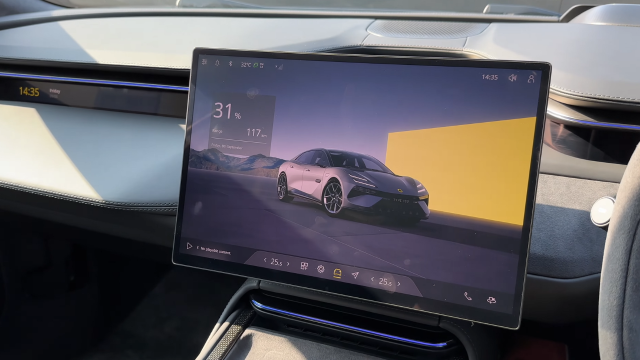I feel like I’m writing up an article about car features every week, talking about extremely unnecessary user interfaces, praying for the return of buttons to cars. But every now and then, an automaker takes things a step further and does something that horseshoes between being both ‘extremely cool’ and ‘why would you do this I just want physical buttons, please’. Enter the Lotus Emeya.
The Lotus Emeya is the British automaker’s latest EV. It packs a WLTP range of about 600km, with DC fast charging support of up to 350kW (so, at optimal speed, you could go from 0 to 80 per cent in just 18 minutes). It’s expected to be an expensive toy (no surprises there — it’s Lotus, after all), with a 0-100km/h speed of just 2.8 seconds and an AWD drivetrain. Not to leave it unsaid, but obviously, it’s gorgeous. Lotus doesn’t miss on aesthetics.
It also, to the confusion of many people online, features the Unreal Engine in the centre console – a gaming engine that powers games like Fortnite and Borderlands. But not for playing games, mind you, this isn’t a Tesla — but for making the UI pop as much as possible.
This was brought to my attention by Marques Brownlee’s post on Twitter (X?), but if you’d like a full walk-around of the car, he’s uploaded one to YouTube.
This new electric Lotus is hot… but using a video game engine for rendering car UI is possibly even hotter (working on a full video about the rest of the car) pic.twitter.com/sZ6OmEWA36
— Marques Brownlee (@MKBHD) September 8, 2023
What’s happening in the footage above is an example of ‘digital twin’ technology. Unlike other cars that may provide 3D models or graphics of their exteriors on the centre screen, the Emeya responds in real-time to any changes that may impact the graphic, and adjusts accordingly. Turning the wheels, for example, will be displayed on the screen, with the front wheels aligned to match how you’ve turned them. Opening the doors, charge port, and boot do the same.
And it’s kind of fun, right? Having this kind of on-screen graphic is (mostly) harmless and it adds to the futurist aesthetic of the rest of the car. It’s also not the first car to do this – Rivian, for example, also uses the Unreal engine for a similar effect, as does Tesla with the Godot engine.
But it’s also very much an unnecessary feature, slapped on an iPad-sized screen in the middle of the dashboard. Responses to Brownlee’s tweet have been mixed, including fans praising it, and critics scratching their heads at why anyone would want this kind of functionality.
Perhaps my favourite reaction? Folks noting that Unreal is prone to crashing when under a lot of processing load.
https://t.co/YfKn68lrJy pic.twitter.com/M5yoD1XPqf
— Dan Smith (@voxelized) September 9, 2023
But look, it’s a luxury car from a luxury automaker – these things are typically designed with all kinds of keys to jingle around factored in (see: the Tesla fart button).
I think it’s fun, but as fun as it is, it’s unnecessary, and I would hate to have essential features provided through the centre console denied because of an Unreal Engine crash. I would also just like buttons.
Image credit: Auto Focus on YouTube
Want more Aussie car news? Here’s every EV we’ve reviewed in the last two years, all the EVs we can expect down under soon, and our guide to finding EV chargers across the country. Check out our dedicated Cars tab for more.
